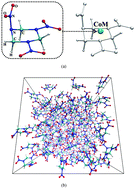On the importance of shear dissipative forces in coarse-grained dynamics of molecular liquids†
Abstract
In this work we demonstrate from first principles that the shear frictions describing dissipative forces in the direction normal to the vector connecting the coarse-grained (CG) particles in dissipative particle dynamics (DPD) could be dominant for certain real molecular liquids at high-resolution coarse-graining. This is in contrast to previous works on bottom-up DPD modeling and indicates that such liquids cannot be simulated accurately using the conventional form of DPD which relies only on frictions in the radial direction. Specifically, we describe the development of fully bottom-up CG models for liquid hexahydro-1,3,5-trinitro-s-triazine (RDX) which are incorporated into the DPD method. Consistent with the microscopic foundation of DPD dynamics, the conservative part of the DPD models is obtained by the multi-scale coarse-graining (MS-CG) approach, which implements the pairwise decomposition of the atomistic potential of mean force (PMF) in CG coordinates. The radial and shear distant-dependent friction coefficients in a parameter-free form are derived systematically from microscopic velocity and force correlation data along system trajectories using a recently proposed approach [J. Chem. Phys., 2014, 140, 104104]. The shear dissipative forces for the reported system appear to be dominant. We discuss the implications of dominant shear dissipation on dynamical and transport properties of CG liquids such as diffusion and viscosity as revealed by simulations of liquid RDX using the new MS-CG/DPD models.


 Please wait while we load your content...
Please wait while we load your content...